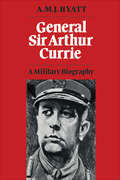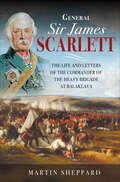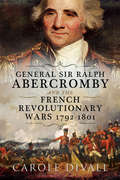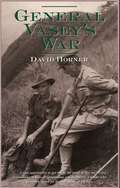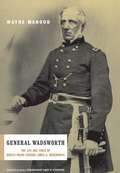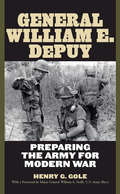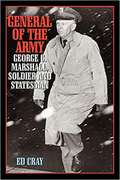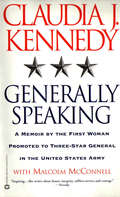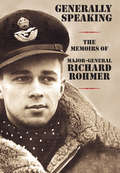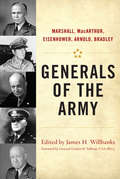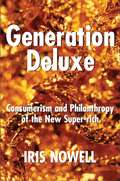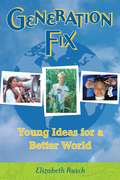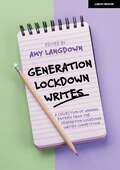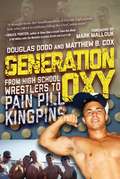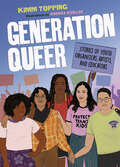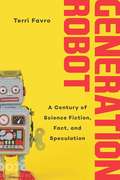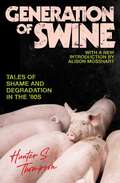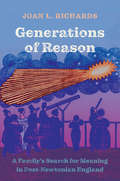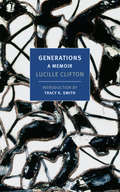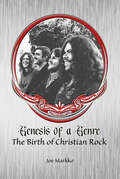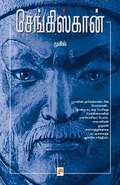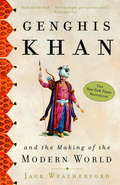- Table View
- List View
General Sir Arthur Currie: A Military Biography (Canadian War Museum Historical Publication #no. 22)
by A.M.J. HyattThe most important Canadian in the First World War, Arthur Currie was an extraordinary successful field commander in a war that produced few successful generals. In this biography A.M.J. Hyatt recalls the military career of a remarkable man.<P><P> Currie's achievements were realized in spite of some formidable obstacles. He was not a professional soldier, having been a civilian before the war. He entered the war under the shadow of a scandal, which, had it been disclosed at the time, would certainly have brought public disgrace. He was not a charismatic man; he had none of the personal flair of so many successful military leaders. In many ways these apparently negative factors make his story all the more remarkable, the secret of his success the more intriguing. That secret, as Hyatt explains, was a fine sense of tactics: Currie, the 'amateur' soldier, had all the instincts of a dedicated professional, and he used them to minimize the destruction of the young Canadian troops under his command.<P> When the war was over Currie returned to civilian life, and was knighted for his service. This biography offers the first balanced account of a central figure in Canadian military history.
General Sir James Scarlett: The Life and Letters of the Commander of the Heavy Brigade at Balaklava
by Martin SheppardThe morning of the Battle of Balaklava, on 25 October 1854, saw a desperate charge against a greatly superior Russian force. Epitomised by the reckless courage of the British cavalry in the face of heavy odds, the charge was a complete success, putting the Russians to flight. This charge was not that of the Light Brigade, which took place later the same day, but that of the Heavy Brigade, under the command of General James Scarlett. Caught by surprise, Scarlett dressed the three hundred men nearest to him, placed himself well ahead of them and charged uphill to an extraordinary and unlikely victory. The Charge of the Heavy Brigade, a resounding success, has unjustly been overshadowed by the blunders that led to the heroic defeat of the Charge of the Light Brigade. James Scarlett himself has also been unfairly ignored due the focus on the enmity between the Earls of Cardigan and Lucan. The strategic significance of the Heavy Brigade’s victory, preventing the Russians capturing the key British base, the port of Balaklava, has been overlooked, as has General Scarlett’s decisive part in thwarting Russia’s best chance of winning the Crimean War. Although his heroic leadership at Balaklava was undoubtedly the most important event in James Scarlett’s life, he had a long and distinguished military career before and after the Crimean War. Based on his own previously unpublished letters, including a long description of his day at Balaklava, General Sir James Scarlett is the first book focused on a remarkable soldier.
General Sir Ralph Abercromby and the French Revolutionary Wars, 1792–1801
by Carole DivallThis biography of the Victorian era general and politician sheds light on Britain&’s military maneuverings against the First French Republic. The French Revolutionary Wars of 1793-1801 were a critical turning point in the political and diplomatic history of Europe, and Sir Ralph Abercromby played a leading role in the British military campaigns that were part of them. In this absorbing and perceptive study, Carole Divall throws new light onto Britain&’s position during the late eighteenth century, focusing on its military affairs and the expeditionary forces led by Abercromby during the conflict. After the convulsions of the French revolution, the tension between Britain and France only grew. British waged an economic war by attacking French colonial possessions, and money and men were sent to campaign on the continent. Abercromby was the most notable British general to exercise command of these expeditions, and his actions and experiences are central to the narrative. He led British forces during the disastrous campaign in Flanders, achieved some success in St Lucia and Trinidad, failed at Den Helder and finally triumphed in Egypt where he lost his life in 1801.
General Vasey's War
by David HornerTo his troops he was 'Bloody George', a hard-bitten professional soldier, technically competent and tactically proficient. His brigade bore the brunt of the fighting in Greece. He commanded the entire Australian force in Crete in the battle against German airborne invaders. He directed the Australian advance from Kokoda and presided over the defeat of the Japanese in the savage battles of the beachheads. But there was more to Major-General George Vasey than his impressive record. Through the existence of a remarkable collection of letters to his wife, Jessie, we have a rare opportunity to get inside the mind of this successful commander. The picture that emerges is one that his closest comrades knew—one of compassion and humanity, a commander who genuinely cared for the well-being of his men. General Vasey's War analyses Vasey's military performance but it also allows us to share Vasey's private thoughts— his frustrations and triumphs, his hopes and cares. Through a unique insight into one man's war we are rewarded with a better understanding of the practice of warfare during those momentous years.
General Wadsworth: The Life and Times of Brevet Major General James S. Wadsworth
by Wayne MahoodJames S. Wadsworth was a successful lawyer and influential New York politician when the Civil War broke out. His wealth, strong anti-slavery views, and active support of President Lincoln made him a controversial public figure in the early war years. In 1863, he was given a field command and proved himself to be one of the Union's most able and daring commanders, although he died before the war ended. His battlefield boldness and righteous resolve to end slavery is, as former U. S. Congressman James W. Symington says, "a vivid reminder that our Civil War was, indeed, fought on moral grounds. "
General William E. DePuy: Preparing the Army for Modern War (American Warriors Series)
by Henry G. GoleThis &“excellent biography&” of one of the US Army&’s unsung heroes &“provides a much-needed re-examination of the early post-Vietnam Army" (Bowling Green Daily News). By the 1970s, the United States Army was demoralized by the outcome of the Vietnam War and shifting attitudes at home. The institution as a whole needed to be reorganized and reinvigorated—and General William E. DePuy was the man for the job. In 1973, DePuy was appointed commander of the newly established Training and Doctrine Command (TRADOC). By integrating training, doctrine, combat developments, and management in the US Army, he cultivated a military force prepared to fight and win in modern war. General William E. DuPuy is the first full-length biography of this key figure in American military history. With extensive interviews with those who knew DePuy, as well as access to his personal papers, Henry G. Gole chronicles and analyzes his unique contributions to the Army and nation. Gole guides the reader from DePuy's boyhood and college days in South Dakota through the major events and achievements of his life. During World War II, DePuy served in the 357th Infantry Regiment in Europe from the Normandy invasion until 1945, when he was stationed in Czechoslovakia. DePuy was asked by George Patton to serve as his aide; he supervised clandestine operations in China; he was instrumental in establishing Special Forces in Vietnam; and he briefed President Lyndon B. Johnson in the White House. But his finest contribution was fixing a broken Army.
General of the Army: George C. Marshall, Soldier and Statesman
by Ed CrayAs the U.S. Army's Chief of Staff through World War II, George Catlett Marshall (1880-1959) organized the military mobilization of unprecedented numbers of Americans and decisively shaped the Allied strategy that defeated first Nazi Germany, then Imperial Japan. As President Truman's Secretary of State, and later as his Secretary of Defense during the Korean War, Marshall the statesman created the European Recovery Act (known as the Marshall Plan), made possible the Berlin Airlift, and was awarded the Nobel Peace Prize. This masterful biography brings the reader face to face with a genuine American hero.
Generally Speaking: A Memoir by the First Woman Promoted to Three-star General in the United States Army
by Claudia J. KennedyWhen Claudia Kennedy retired from the United States Army in June 2000, she had made history by becoming the Army's first woman three-star general. The highest-ranking female officer of her time, she was Deputy Chief of Staff for Intelligence, overseeing 45,000 soldiers worldwide. Now a military analyst for NBC News, General Kennedy describes her thirty-two-year career, which spanned a time of monumental transformation for the military. She tells how -- just after the Army began to allow women officers to command men -- she was placed in charge of a rebellious, out-of-control company where she restored order and respect. She shows us the daunting challenges she faced over the years, from the DMZ in South Korea to the offices of the Pentagon. And she reveals how one of our most revered and misunderstood institutions really operates...as we meet a superlative leader who both witnessed groundbreaking changes in the Army and helped make them.
Generally Speaking: The Memoirs of Major-General Richard Rohmer
by Richard RohmerLieutenant-General Richard Rohmer is arguably Canada’s most decorated citizen. A commander of the Order of Military Merit and an Officer of the Order of Canada, his career began in World War II where he earned the reputation as one of Canada’s top Mustang reconnaissance pilots. For his service, which includes flying over the beaches of Normandy on D-Day, he received the Distinguished Flying Cross. A lawyer, litigator, journalist and best-selling author of 28 fiction and non-fiction books, Rohmer has met with such public figure as Queen Elizabeth, General George Patton, "Intrepid" Sir William Stephenson, Presidents Eisenhower, Regan, and Clinton, and has flown with John F. Kennedy. He is currently a member of the board of directors of Hollinger Inc. Recently, he chaired the 60th anniversary of the D-Day Advisory Committee to the Minister of Veterans Affairs. His autobiography, Generally Speaking: The Memoirs of Richard Rohmer, is written with Rohmer’s characteristic frankness and insight.
Generals of the Army: Marshall, MacArthur, Eisenhower, Arnold, Bradley (American Warriors Series)
by James H. Willbanks&“A concise account of the extraordinary careers of the five men who had perhaps the greatest impact on the US military of the late twentieth century.&” —Andrew Wiest, author of The Boys of &’67: Charlie Company&’s War in Vietnam Formally titled &“General of the Army,&” the five-star general is the highest possible rank awarded in the U.S. Army in modern times and has been awarded to only five men in the nation&’s history: George C. Marshall, Douglas MacArthur, Dwight D. Eisenhower, Henry H. Arnold, and Omar N. Bradley. In addition to their rank, these distinguished soldiers all shared the experience of serving or studying at Fort Leavenworth, Kansas, where they gained the knowledge that would prepare them for command during World War II and the Korean War. In Generals of the Army, James H. Willbanks assembles top military historians to examine the connection between the institution and the success of these exceptional men. Historically known as the &“intellectual center of the Army,&” Fort Leavenworth is the oldest active Army post west of Washington, D.C., and one of the most important military installations in the United States. Though there are many biographies of the five-star generals, this innovative study offers a fresh perspective by illuminating the ways in which these legendary figures influenced and were influenced by Leavenworth. This concise volume offers an intriguing look at the lives of these remarkable men and the contributions they made to the defense of the nation. &“An excellent review of the lives and challenges, on and off the battlefield, during trying times for our country.&” —Ike Skelton, Former Chairman, House Armed Services Committee, US Congress
Generation Deluxe: Consumerism and Philanthropy of the New Super-Rich
by Iris NowellThey fork out 100 million for starter castles, 500,000 for a customized Mercedes, and 1.2 million for a watch. While Generation Deluxe explores the spending patterns of the wealthy, a dark underside emerges: excessive consumerism is creating serious damage to the environment and human life. Simultaneously, the super-rich - and celebrities - are raising awareness and spending multi-millions cleaning up the damage and, as never before, funding solutions to global problems of poverty, hunger, and disease prevention.
Generation Fix: Young Ideas for a Better World
by Elizabeth RuschStories of real teens creating change show readers how they too can make the world a better place.GENERATION FIX is the only kid's book that features real life stories of kids doing incredible things to make the world a better place. Capturing kids ideas on how to solve the problems that we face in this world - hunger, homelessness, violence, discrimination, and problems with health care, education, and the environment - the book also inspires them to take action with their own ideas and resources. GENERATION FIX profiles 20+ kids who have changed the world by taking action on their ideas. Each chapter also includes resources and activities for kids to get involved right now in their communities and a place for kids to write down their own solutions to world problems. The book will include smart, funny, and dead serious ideas for kids across the country who are brainstorming methods for improving the world.
Generation Lockdown Writes: A collection of winning entries from the 'Generation Lockdown Writes' competition
by Amy LangdownApril 2020: the country is deep in the first lockdown as a result of coronavirus. Young people are left rootless, without school or friends and isolated at home. In this enforced alienation a creative writing competition, ‘Generation Lockdown Writes’, was launched for young people from the ages of seven to 17. The only rule was that submissions to the competition had to provide an insight into what life was like for them in lockdown – to open up windows of homes and experiences across the UK. Some of Britain’s finest authors for young people stepped in to judge the ten individual categories, and the entries flooded in. ‘Generation Lockdown Writes’ is the stunning final collection of the winning entries, chosen from over six thousand entries. The beautiful and varied pieces provide a unique insight into what life was really like for young people during this historical moment across Britain. We enter many different worlds, and are given a remarkable insight into the range of emotions that young people felt. From moments of fear to joy, this is a collection of writing that will linger in the memory for a long time.Profits from the sale of this book will be donated to BookTrust.
Generation Lockdown Writes: A collection of winning entries from the 'Generation Lockdown Writes' competition
by Amy LangdownApril 2020: the country is deep in the first lockdown as a result of coronavirus. Young people are left rootless, without school or friends and isolated at home. In this enforced alienation a creative writing competition, ‘Generation Lockdown Writes’, was launched for young people from the ages of seven to 17. The only rule was that submissions to the competition had to provide an insight into what life was like for them in lockdown – to open up windows of homes and experiences across the UK. Some of Britain’s finest authors for young people stepped in to judge the ten individual categories, and the entries flooded in. ‘Generation Lockdown Writes’ is the stunning final collection of the winning entries, chosen from over six thousand entries. The beautiful and varied pieces provide a unique insight into what life was really like for young people during this historical moment across Britain. We enter many different worlds, and are given a remarkable insight into the range of emotions that young people felt. From moments of fear to joy, this is a collection of writing that will linger in the memory for a long time.Profits from the sale of this book will be donated to BookTrust.
Generation Oxy: From High School Wrestlers to Pain Pill Kingpins
by Douglas Dodd Matthew CoxGeneration Oxy is the story of a group of friends—clean cut, all-American high school kids—who stumbled into the Sunshine State’s murky underworld of illegal pill mills and corrupt doctors. This teenage criminal enterprise ultimately shipped hundreds of thousands of OxyContins and other prescription painkillers throughout the country, making millions in the process.This true crime memoir details the three-year-long rise and collapse of the Barabas Criminal Enterprise, an opiod-pill trafficking ring founded by Douglas Dodd and his best friend on the wrestling team, Lance Barabas. Raised by an alcoholic mother and surrounded by drug-abusing relatives, Dodd got involved in narcotics at an early age. Their scheme to sell the drugs he was already consuming coincided with the explosion of prescription addicts who were traveling the “Oxy Express” to Florida for easy access to the pills they dubbed “hillbilly heroin.” Soon they were shipping forty thousand pills a month, with tens of thousands of dollars returning in hollowed-out teddy bears.In Generation Oxy, Dodd recounts his time as a wannabe Scarface: bottle-service at clubs, an arsenal of weapons that would make Dillinger blush, narrow escapes from the law, hordes of young women, and as many pills as he could swallow. And this was all before he was legally able to drink a beer, while still living with his grandmother. The good times came to an end when the DEA closed in and the twenty-year-old Dodd faced life in federal prison.
Generation Queer: Stories of Youth Organizers, Artists, and Educators
by Kimm ToppingActivism. Art. Community care. Education. These are the hallmarks of the work done by the youth highlighted in this collection featuring LGBTQ+ leaders working to make our world more inclusive.Civil Rights activist Marian Wright Edelman once said, "You can't be what you can't see." In this collection of short biographies, readers will see the example of thirty young trailblazers representative of a generation that values intersectional, collaborative social justice and who are working to build a world that values everyone. Meet leaders who founded organizations for their liberation as teenagers, leaders who brought Black transgender representation to people's television screens, and leaders who successfully advocated for access to restrooms for transgender students. Meet the first transgender athlete to compete in Division I sports, and artists advocating for inclusiveness through poetry, film, fashion, and other mediums. Whether their work involves protesting, working with policymakers for change, or just existing in the world as their creative selves, each of these young leaders shares what brings them joy and keeps them motivated to do the work they do-- even when it's hard--and their hope for better things to come.
Generation Robot: A Century of Science Fiction, Fact, and Speculation
by Terri FavroGeneration Robot covers a century of science fiction, fact and, speculation—from the 1950 publication of Isaac Asimov’s seminal robot masterpiece, I, Robot, to the 2050 Singularity when artificial and human intelligence are predicted to merge. Beginning with a childhood informed by pop-culture robots in movies, in comic books, and on TV in the 1960s to adulthood where the possibilities of self-driving cars and virtual reality are daily conversation, Terri Favro offers a unique perspective on how our relationship with robotics and futuristic technologies has shifted over time. Peppered with pop-culture fun-facts about Superman’s kryptonite, the human-machine relationships in the cult TV show Firefly, and the sexual and moral implications of the film Ex Machina, Generation Robot explores how the techno-triumphs and resulting anxieties of reality bleed into the fantasies of our collective culture.Clever and accessible, Generation Robot isn’t just for the serious, scientific reader—it’s for everyone interested in robotics and technology since their science-fiction origins. By looking back at the future she once imagined, analyzing the plugged-in present, and speculating on what is on the horizon, Terri Favro allows readers the chance to consider what was, what is, and what could be. This is a captivating book that looks at the pop-culture of our society to explain how the world works—now and tomorrow.
Generation of Swine
by Hunter S. ThompsonGeneration of Swine, the second volume of the legendary Dr. Hunter S. Thompson's bestselling "Gonzo Papers," was first published in 1988 and is now back in print. Here, against a backdrop of late-night tattoo sessions and soldier-of-fortune trade shows, Dr. Thompson is at his apocalyptic best -- covering emblematic events such as the 1987-88 presidential campaign, with Vice President George Bush, Sr., fighting for his life against Republican competitors like Alexander Haig, Pat Buchanan, and Pat Robertson; detailing the GOP's obsession with drugs and drug abuse; while at the same time capturing momentous social phenomena as they occurred, like the rise of cable, satellite TV, and CNN -- 24 hours of mainline news. Showcasing his inimitable talent for social and political analysis, Generation of Swine is vintage Thompson -- eerily prescient, incisive, and enduring.
Generation of Swine: The Brutal Odyssey of an Outlaw Journalist
by Hunter S. ThompsonFrom the bestselling author of Fear and Loathing in Las Vegas, the legendary Hunter S. Thompson's second volume of the "Gonzo Papers" is back. Generation of Swine collects hundreds of columns from the infamous journalist's 1980s tenure at the San Francisco Examiner.Here, against a backdrop of late-night tattoo sessions and soldier-of-fortune trade shows, Dr. Thompson is at his apocalyptic best--covering emblematic events such as the 1987-88 presidential campaign, with Vice President George Bush, Sr., fighting for his life against Republican competitors like Alexander Haig, Pat Buchanan, and Pat Robertson; detailing the GOP's obsession with drugs and drug abuse; while at the same time capturing momentous social phenomena as they occurred, like the rise of cable, satellite TV, and CNN--24 hours of mainline news. Showcasing his inimitable talent for social and political analysis, Generation of Swine is vintage Thompson--eerily prescient, incisive, and enduring.
Generations of Captivity: A History of African-American Slaves
by Ira Berlin<P>Ira Berlin traces the history of African-American slavery in the United States from its beginnings in the seventeenth century to its fiery demise nearly three hundred years later. <P>Most Americans, black and white, have a singular vision of slavery, one fixed in the mid-nineteenth century when most American slaves grew cotton, resided in the deep South, and subscribed to Christianity. Here, however, Berlin offers a dynamic vision, a major reinterpretation in which slaves and their owners continually renegotiated the terms of captivity. Slavery was thus made and remade by successive generations of Africans and African Americans who lived through settlement and adaptation, plantation life, economic transformations, revolution, forced migration, war, and ultimately, emancipation. <P>Berlin's understanding of the processes that continually transformed the lives of slaves makes Generations of Captivity essential reading for anyone interested in the evolution of antebellum America. Connecting the "Charter Generation" to the development of Atlantic society in the seventeenth century, the "Plantation Generation" to the reconstruction of colonial society in the eighteenth century, the "Revolutionary Generation" to the Age of Revolutions, and the "Migration Generation" to American expansionism in the nineteenth century, Berlin integrates the history of slavery into the larger story of American life. He demonstrates how enslaved black people, by adapting to changing circumstances, prepared for the moment when they could seize liberty and declare themselves the "Freedom Generation." <P>This epic story, told by a master historian, provides a rich understanding of the experience of African-American slaves, an experience that continues to mobilize American thought and passions today.
Generations of Reason: A Family's Search for Meaning in Post-Newtonian England
by Joan L. RichardsAn intimate, accessible history of British intellectual development across the eighteenth and nineteenth centuries, through the story of one family This book recounts the story of three Cambridge-educated Englishmen and the women with whom they chose to share their commitment to reason in all parts of their lives. The reason this family embraced was an essentially human power with the potential to generate true insight into all aspects of the world. In exploring the ways reason permeated three generations of English experience, this book casts new light on key developments in English cultural and political history, from the religious conformism of the eighteenth century through the Napoleonic era into the Industrial Revolution and prosperity of the Victorian age. At the same time, it restores the rich world of the essentially meditative, rational sciences of theology, astronomy, mathematics, and logic to their proper place in the English intellectual landscape. Following the development of their views over the course of an eventful one hundred years of English history illuminates the fine structure of ways reason still operates in our world.
Generations: A Memoir
by Lucille CliftonA moving family biography in which the poet traces her family history back through Jim Crow, the slave trade, and all the way to the women of the Dahomey people in West Africa. Buffalo, New York. A father&’s funeral. Memory. In Generations, Lucille Clifton&’s formidable poetic gift emerges in prose, giving us a memoir of stark and profound beauty. Her story focuses on the lives of the Sayles family: Caroline, &“born among the Dahomey people in 1822,&” who walked north from New Orleans to Virginia in 1830 when she was eight years old; Lucy, the first black woman to be hanged in Virginia; and Gene, born with a withered arm, the son of a carpetbagger and the author&’s grandmother. Clifton tells us about the life of an African American family through slavery and hard times and beyond, the death of her father and grandmother, but also all the life and love and triumph that came before and remains even now. Generations is a powerful work of determination and affirmation. &“I look at my husband,&” Clifton writes, &“and my children and I feel the Dahomey women gathering in my bones.&”
Genesis of a Genre: The Birth Of Christian Rock
by Joe MarkkoContemporary Christian Music is still four years away from being “a thing.” Larry Norman, one of the progenitors of the emerging genre, has just released his first Christian album, “Upon This Rock.” Amy Grant is 9 years old. Matthew Ward, of the 2nd Chapter of Acts, is eleven. At the Salt Company Coffee House in Hollywood, Larry Norman shared the platform with a Southern California “power-trio” who called themselves, Agape. Intrigued by the gritty and unapologetically loud “blues-edge” to their music, Larry Norman “came out of his seat,” excited by the possibilities. No one else in his experience had yet married such hard-driving, high-energy rock music to the Gospel message. Playing out against the backdrop of the Jesus Movement – the “Fourth Great Awakening” in American Evangelical history – 20,000 people were reported to have responded to Agape’s audacious, Gospel message. And then, at their peak, they simply disappeared. A prequel to Contemporary Christian Music, the untold story of Agape is a story of beginnings; the Genesis of a Genre. It’s a tale about “the days of old” and The Birth of Christian Rock, when minstrels became messengers and the Word became flesh once again.
Genghis Khan
by MugilThe book tells the story of 13th century Mongolian conqueror named Temujin, popularly known as Genghis Khan.
Genghis Khan and the Making of the Modern World
by Jack WeatherfordThe name Genghis Khan often conjures the image of a relentless, bloodthirsty barbarian on horseback leading a ruthless band of nomadic warriors in the looting of the civilized world. But the surprising truth is that Genghis Khan was a visionary leader whose conquests joined backward Europe with the flourishing cultures of Asia to trigger a global awakening, an unprecedented explosion of technologies, trade, and ideas. In Genghis Khan and the Making of the Modern World, Jack Weatherford, the only Western scholar ever to be allowed into the Mongols' "Great Taboo"--Genghis Khan's homeland and forbidden burial site--tracks the astonishing story of Genghis Khan and his descendants, and their conquest and transformation of the world. Fighting his way to power on the remote steppes of Mongolia, Genghis Khan developed revolutionary military strategies and weaponry that emphasized rapid attack and siege warfare, which he then brilliantly used to overwhelm opposing armies in Asia, break the back of the Islamic world, and render the armored knights of Europe obsolete. Under Genghis Khan, the Mongol army never numbered more than 100,000 warriors, yet it subjugated more lands and people in twenty-five years than the Romans conquered in four hundred. With an empire that stretched from Siberia to India, from Vietnam to Hungary, and from Korea to the Balkans, the Mongols dramatically redrew the map of the globe, connecting disparate kingdoms into a new world order. But contrary to popular wisdom, Weatherford reveals that the Mongols were not just masters of conquest, but possessed a genius for progressive and benevolent rule. On every level and from any perspective, the scale and scope of Genghis Khan's accomplishments challenge the limits of imagination. Genghis Khan was an innovative leader, the first ruler in many conquered countries to put the power of law above his own power, encourage religious freedom, create public schools, grant diplomatic immunity, abolish torture, and institute free trade. The trade routes he created became lucrative pathways for commerce, but also for ideas, technologies, and expertise that transformed the way people lived. The Mongols introduced the first international paper currency and postal system and developed and spread revolutionary technologies like printing, the cannon, compass, and abacus. They took local foods and products like lemons, carrots, noodles, tea, rugs, playing cards, and pants and turned them into staples of life around the world. The Mongols were the architects of a new way of life at a pivotal time in history. In Genghis Khan and the Making of the Modern World, Jack Weatherford resurrects the true history of Genghis Khan, from the story of his relentless rise through Mongol tribal culture to the waging of his devastatingly successful wars and the explosion of civilization that the Mongol Empire unleashed. This dazzling work of revisionist history doesn't just paint an unprecedented portrait of a great leader and his legacy, but challenges us to reconsider how the modern world was made.From the Hardcover edition.
